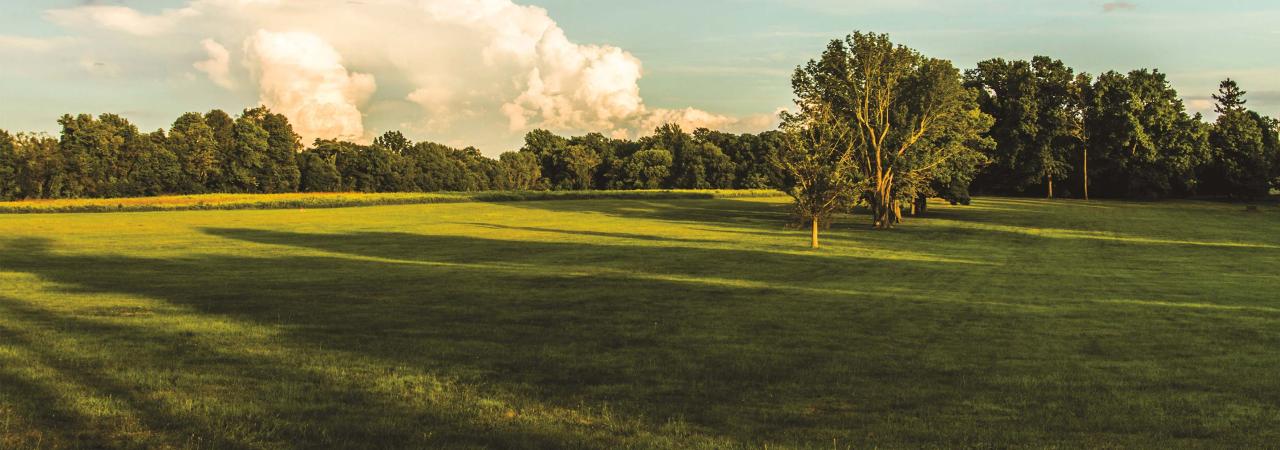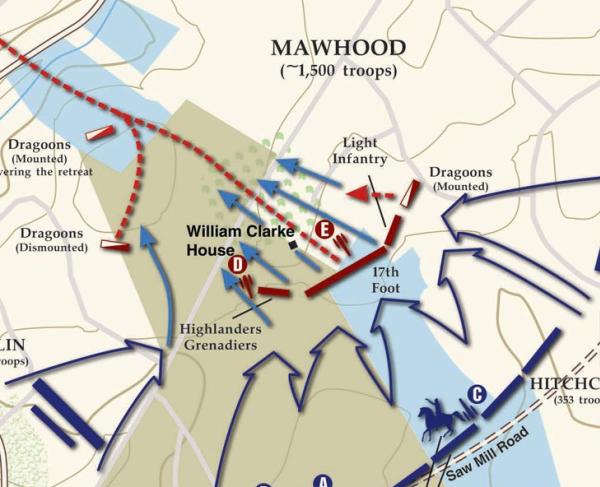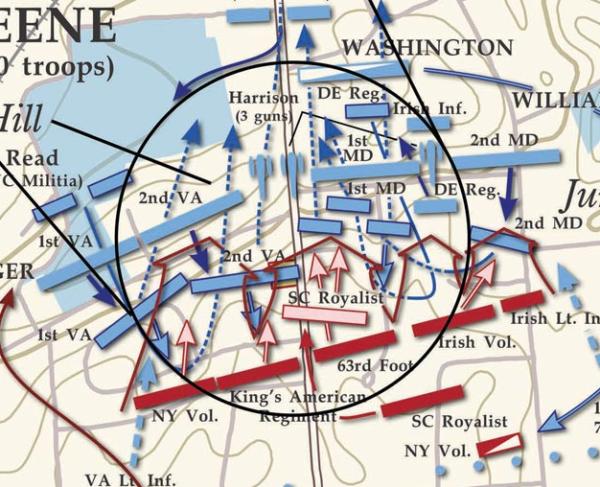
Princeton Battlefield, N.J.
Help Save 261 Acres of Revolutionary War History
The Opportunity
We have the chance to save an incredible 261 acres of highly significant Revolutionary War battlefield land AND fund a project that will bring the pivotal story of the Princeton Battlefield to life.
The total value of the battlefield land plus the project to restore and interpret the Princeton Battlefield is more than $1.6 million, but with anticipated state and federal matching grants, private funding, as well as a special matching grant for the Princeton project, we need to raise only one-tenth of that total.
If you can help us raise $171,750, we’ll unlock a match that will multiply this amount tenfold!
The History
Maxwell’s Field – Princeton, New Jersey
The ink on the Declaration of Independence was barely dry on the frigid morning of January 3, 1777. Eager to follow up on his improbable victory at Trenton, General George Washington and his outnumbered forces managed to evade Cornwallis’s main army in a night march. Their plan was to attack the British rear guard and baggage train at Princeton.
But as Washington’s forces approached the town, the British commander spotted the American vanguard, and fighting ensued. Lines of infantry blazed away at each other, a mere 40 yards apart, until finally, the Redcoats launched a furious bayonet attack. It worked. The American line wavered.

American General Hugh Mercer — fighting off the blows with his sword — was bayonetted seven times and left for dead, as were many other American officers and men. With the army on the brink of destruction, George Washington plunged into this swirling chaos, sitting tall on his white horse.
Heedless of danger and rallying his men, he gave the order to advance across Maxwell’s Field, and led them to within 30 yards of the British line. He ordered them to then fire. The British returned the volley. Historian W. J. Wood writes that...
“Colonel John Fitzgerald of [Washington’s] staff covered his eyes so that he would not see his commander blasted from the saddle. Yet when the smoke began to clear, there was Washington, standing in his stirrups, calmly waving his men forward.”
It was too much for the British, and now it was their turn to break and run. Some British soldiers retreated all the way to Nassau Hall (located on the campus of what is now Princeton University), until Continental artillery fired a few shots into the grand building.
The British defenders finally waved a white flag, ending the Battle of Princeton, and closing out the Ten Crucial Days that emboldened a burgeoning nation and changed the trajectory of the American Revolutionary War.
“If George Washington’s audacity on January 3, 1777, had not reversed the Patriots’ retreat and routed the advancing British, the American Revolution might have been extinguished.” - Pulitzer Prize-winning journalist George Will
The hallowed ground of Princeton is also the site of one of the Trust’s most significant victories.
In 2017, the Trust was able to purchase 15 acres at the Princeton Battlefield’s Maxwell’s Field, where George Washington rallied his troops and led a counterattack that drove the British from the field. This land will be incorporated into the Princeton Battlefield State Park, providing current and future generations with the opportunity to walk in the footsteps of those who sacrificed all to secure American independence.
Now, it’s time to transform this state park into a national destination for millions of patriotic visitors during the anniversary period. And we need your help.
I’m thrilled to announce that over the course of the next several years, the Trust will be embarking upon a multi-faceted project to reinvigorate the interpretive and educational experience at the Princeton Battlefield, integrating the newly protected areas into the existing parkland along the way.
The first part of this watershed project involves developing and installing interpretive signage to help visitors make a meaningful connection with the historic landscape. These efforts will accompany measures like:
- restoring historic tree lines,
- re-planting an orchard that existed in 1777,
- removing non-historic structures,
- and more to help fully tell the story of the battle.
Over the next two years, we’re planning to install and launch a new and exciting suite of innovative interpretive methods, via digital tools and interactive signage, to complement the restored battlefield and create a robust experience for the modern visitor. History will come to life like never before.
Learn even more about the history behind and the vision for this innovative project, which has been deemed "Washington's Legacy."
It’s going to take millions of dollars over several years, it’s going to take a team, and it's going to require the active involvement of enthusiastic local stakeholders and government officials. To this end, we are working with community groups, New Jersey State Historic Sites and Parks, the Princeton Battlefield Society, the Municipality of Princeton and a host of other dedicated individuals and organizations in a true public-private partnership on this project.
Though perhaps less well-known, the 1779 Battle of Newtown played a significant role in the Revolutionary War.
By the late 1770s, British strategy involved working with Native American allies to attack Continental settlements on the New York and Pennsylvania frontiers. These constant raids served to divert manpower from the Continental Army, strip the Patriots of their food and supplies, and spread terror throughout the region, leading to frequent counterattacks and retaliatory actions between the Loyalist and Patriot forces and their respective Native American allies.
In the summer of 1779, General Washington ordered General John Sullivan to lead an attack against the Iroquois Nation that would remove them as a threat in the war. Because they were outnumbered 4-to-1, Loyalist and Iroquois forces planned to ambush the Continentals as they approached Newtown. However, several riflemen who had previously served under Daniel Morgan detected the ambush, and the Continentals were able to launch their own attack against the Iroquois and British forces.
Though the Continental plan was complex, the Patriots executed it successfully, forcing the smaller opposing force to retreat after holding the Americans off for nearly two hours. After the battle, Continental forces destroyed Iroquois crops and villages, eliminating them as a threat, but dealing the Native Americans a devastating and demoralizing blow.
The land we are working to save today at Newtown will help tell the story of this battle, and also of the continuous conflict between the Continental forces, Loyalists, and Native American allies that characterized this complicated front of the Revolutionary War.
Even though Hobkirk Hill was a defeat for Patriot General Nathanael Greene, the battle did convince Lieutenant Colonel Francis Lord Rawdon to withdraw from Camden. This forever ended the British occupation of the interior of South Carolina. Casualties on both sides were about evenly matched, with the Americans suffering 270 casualties, and the British suffering 258. Though a victory for British forces, Greene ultimately succeeded in his campaign.
One of the parcels we are working to save at Hobkirk Hill was also the site of the Camden jail, which once held a historically significant occupant — a 14-year-old Andrew Jackson, who was held there as a prisoner of war. You likely know the story — one day, a British officer approached young Jackson and demanded the boy shine his boots. In an act of defiance that was a harbinger of behavior to come, Jackson refused, and the British officer slashed Jackson across the forehead with his sword, literally scarring him for life.
Stories like these, and so many more, are what connect us to our past.
Continue the charge to preserve and share American history
The hallowed ground on the battlefields we seek to save forged the spirit of our nation. They echo with the footsteps of heroes, and they hold the stories of ordinary people who did extraordinary things. They are the heart and soul of our history.
Together with our partners and history enthusiasts like you, we can transform how the public experiences this incredible and formative piece of our history, helping present and future generations foster a deep appreciation of this unique American treasure.
Your support will make a difference! Help us raise the funds needed to secure a $10-to-$1 match! This is our moment to capture the imagination of the country and preserve the battlefields where our independence was won!


